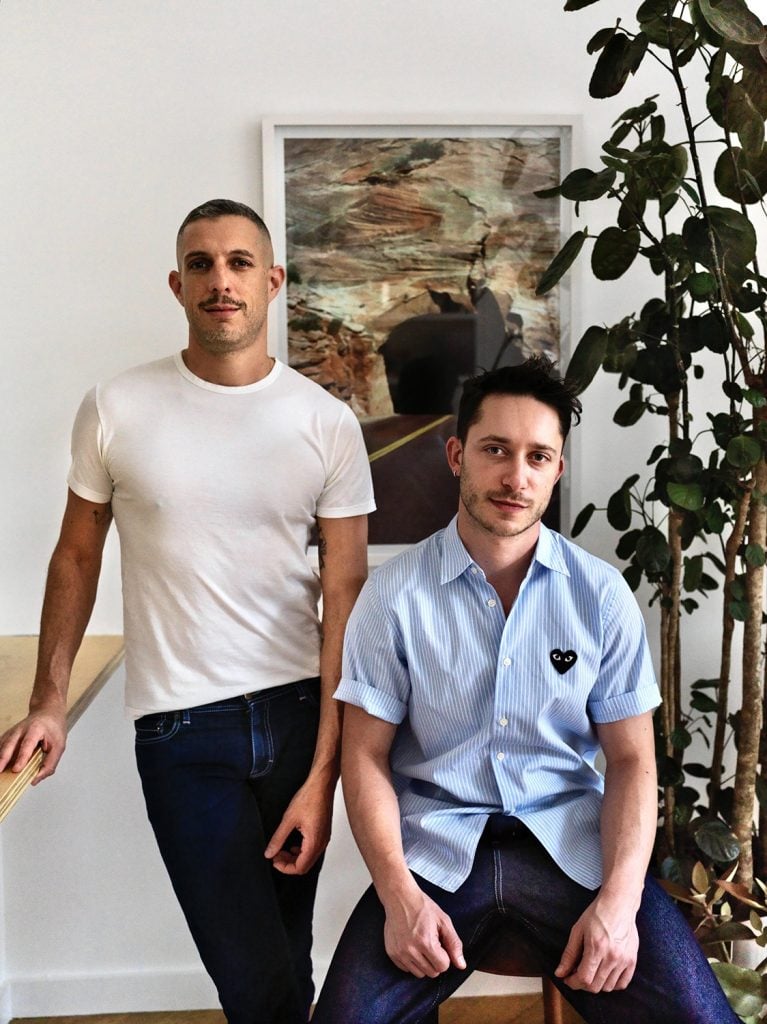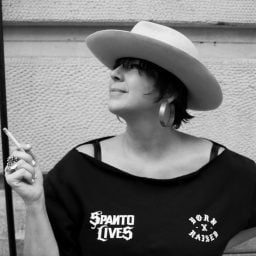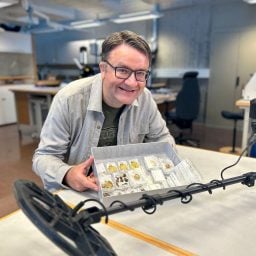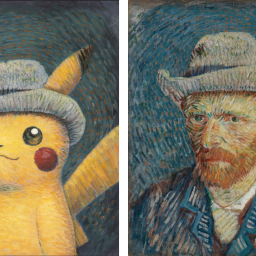Scattered around London’s Design Museum is a series of wooden, adult-size playground equipment that begs for audience participation. But these aren’t your run-of-the-mill backyard amusements. They all look like good fun, but then participants discover that to operate the see-saw one must face backwards, and the experience becomes precarious. Elsewhere, a hammock traps the user upside down like a straitjacket and the rocking horse is akin to medieval stocks.
“The pieces are supposed to make you question the relationship between liminal space and your body,” said the architect Noam Dvir. “They’re supposed to make you feel uncomfortable.” They were commissioned and executed for Fyodor Pavlov-Andreevich’s “Antifurniture”, which opened this week and runs through October 28. Dvir designed the purposefully uncomfortable sculptures with his partner in architecture and life, Daniel Rauchwerger. “Design-wise, they have the language of Soviet kids’ toys,” Rauchwerger said. “They’re super simple, but at the same time the geometry is kind of Constructivist.”
He adds, “Another is like a hamster wheel, but it’s not in this show, actually—they were afraid people would just roll away from the museum and into the Thames.”
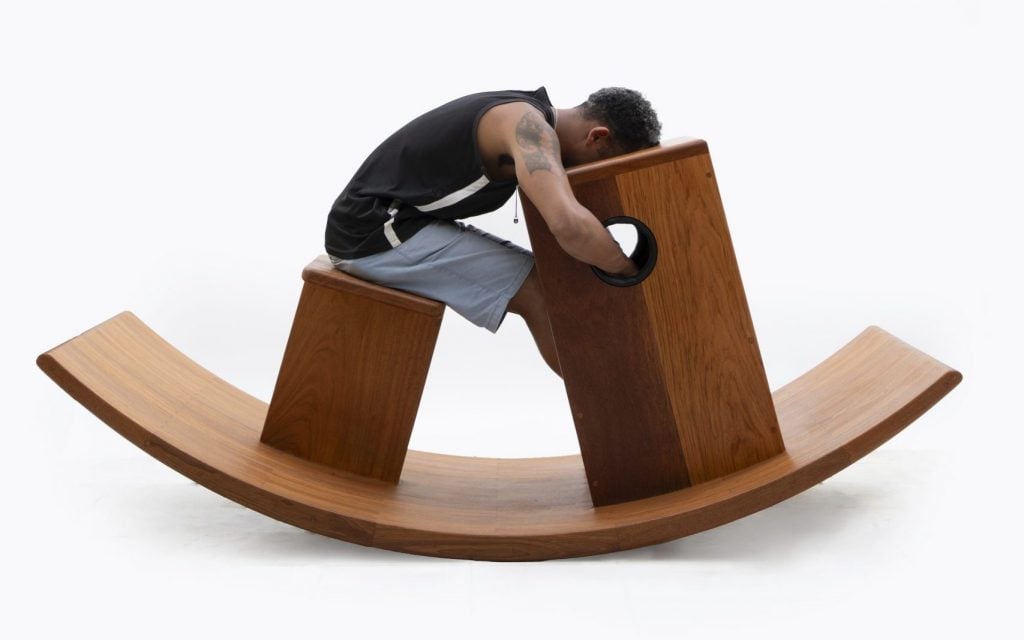
BoND-designed Rock-n’Desk (2023) for Fyodor Pavlov-Andreevich’s “Antifurniture.” Photo: Ruy Teixeira, courtesy of Design Museum.
Dvir and Rauchwerger are the founders of the New York-based BoND (which stands for “Bureau of Noam and Daniel”). The Harvard-educated Israeli couple founded the buzzy firm only in 2020 after stints at OMA and Diller Scofidio + Renfro. “Antifurniture” is its latest venture into the art sphere. “Each of the sculptures is related to a particular phobia,” Pavlov-Andreevich explains. “So, the moment you leave the sculpture, you are in a way fearless.”
The artist’s unorthodox methods include orchestrating collaborators. He described what he wanted for rudimentary sketches and handed them off to BoND. “The way my practice works is I join the right people together and sort of play games with them,” Pavlov-Andreevich said, “making them do things that I need and directing their energies and efforts. I always know what I want, like color, shape, this, that, but I never touch anything. I partner with so many people around the world, and I’m always hunting for new souls, new beautiful people who could contribute.” Pavlov-Andreevich found kindred spirits in Dvir and Rauchwerger.

Dvir and Rauchwerger’s apartment. Courtesy of BoND.
He met the BoND boys through a combination of kismet and party crashing—he accompanied a friend to their apartment for a small get-together and was impressed. “All three of us loved Absalon, this artist who died of AIDS in the early ’90s who made these amazing pure white light sculptures. Whatever artist name I would draw up, they’d immediately know, no matter how obscure,” he said. “Art historians would know, but not architects. This was a completely different situation. These were the partners in crime I’d been looking for.”
He also noticed the intimate, emotive paintings orbiting the austere room, courtesy of Daniel’s father, the artist Jan Rauchwerger. “Most of the works we have here are small because we bring them home in a suitcase,” he said. A particularly striking painting captures his mother, the photographer Galit Rauchwerger, while she was pregnant with Daniel. “Fyodor’s Russian; my dad immigrated from Russia,” Rauchwerger said. “There was so much overlap.”
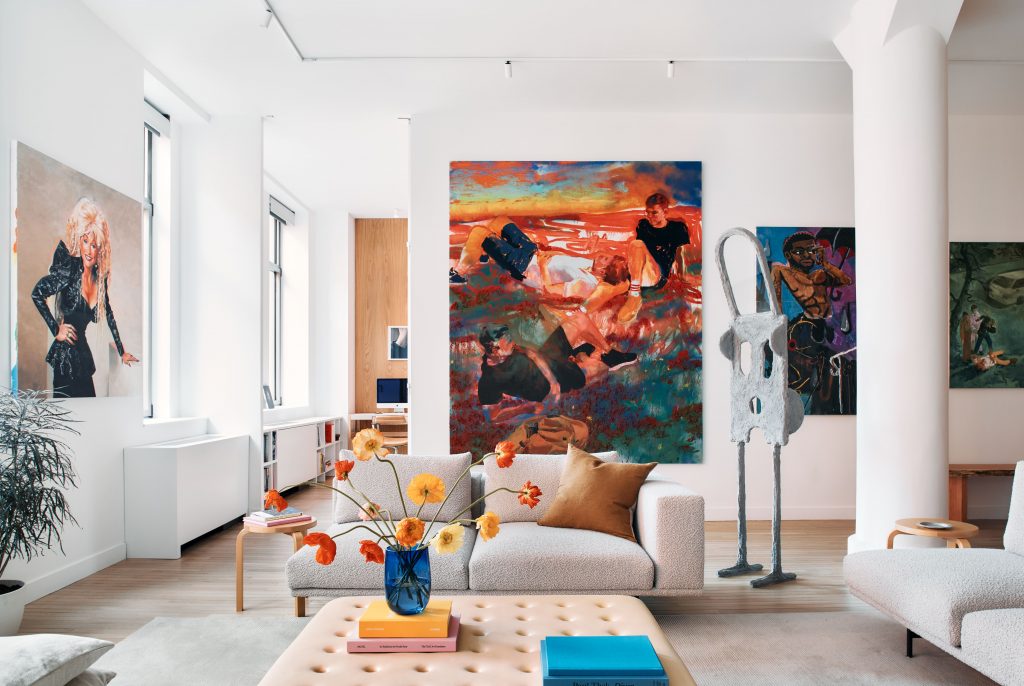
The art collector Ilan Cohen’s BoND-designed Manhattan living room. Photo: Blaine Davis (originally shot for Elle Decor)
Last week, the couple were at their Chelsea apartment in jeans and T-shirts preparing to travel to London for the “Antifurniture” opening. Their home is the perfect showroom for their understated aesthetic, and they sat underneath the wax study for a bronze bust by Daniel’s father. It looked dramatic and ancient and contrasted with the chic BoND-designed plexiglass plinth it was perched atop.
Dvir and Rauchwerger’s first project together at school was in the field of exhibition design, and art has continued to be a through-line in their practice since. “It was just a very clear connection,” Dvir said. “Art is such a driving force for our work and a way to explore new ideas in new spaces.” Rauchwerger adds, “And it’s part of our families and what we grew up with.”
“….And the people that we know and who we like,” Dvir said. “So, we didn’t go and chase a gallery. It came naturally.”
One of the first BoND endeavors was Company Gallery’s NoLiTa outpost. “The founder Sophie Mörner was on the lookout for a new building,” Dvir said. “She asked us to design a new model for a gallery, an ‘anti gallery’ in a way. Your typical Chelsea gallery, you walk in, there’s a frowny face behind a desk in the front, and like a big space, you can’t have people in it. God, forbid you see the staff.”
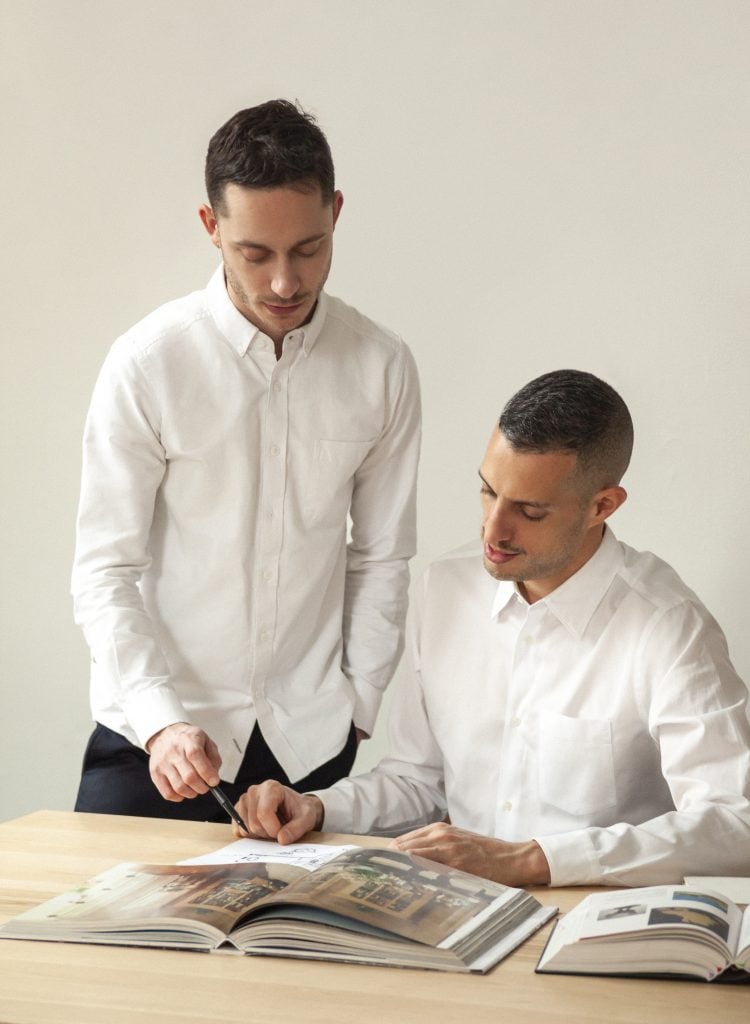
The architects Daniel Rauchwerger and Noam Dvir. Photo: Matthew Richards, courtesy of BoND.
So they decided to so something different. “This was about, how do we turn the gallery inside out and create very different exhibition spaces. The building that we worked within was previously a cold storage warehouse with fridges the size of rooms. We created three different spaces for art. One is like a white box gallery. Another one we call it the ‘Atrium Gallery,’ which is a very tall and narrow space and connected to the street so larger performances or larger sculptures could be displayed. As you go downstairs, there’s a dedicated black box, because again, they do all of this performance and video with a hidden door and you can go into a bar, which is for the community, the hangout and like the art storage.”
Rauchwerger adds, “It’s rethinking the gallery structure and how galleries function, because the company is also about community. And when you walk into the gallery, the staff is sitting in a big table to the left of the entry. They’re all together, all on display.” BoND also designed the nearby David Lewis Gallery.

Curved Bench and Lemon Bar Bench for Le Pere, both being fabricated by Vince Patti from Lesser Miracle. Courtesy of BoND.
In mid-October, their next commercial project, the Lower East Side, Dimes Square-adjacent menswear boutique Le Pere will open with an acid yellow changing room and furniture collaborations with Vince Patti of Lesser Miracle. “It’s designed a bit like an art gallery,” Rauchwerger said. A collaboration with USM Haller is also on the horizon, but BoND can’t release details, yet.
Besides art collectors’ abodes and various urban residential and commercial projects, BoND has become an architectural presence in the gay enclave/design mecca of Fire island Pines, where they own (and designed themselves) a vacation home. “The Pines has such a strong identity,” Rauchwerger said. They’re about to embark on their eighth property there and are aspiring to reclaim some of the rustic Modernist magic that has dissipated. “We’re adding back what was missing for many years,” Dvir explained. “Since the ’90s a lot of the houses became really big. Everybody was painting over the cedar, making it like a white Miami/Malibu kind of thing.”
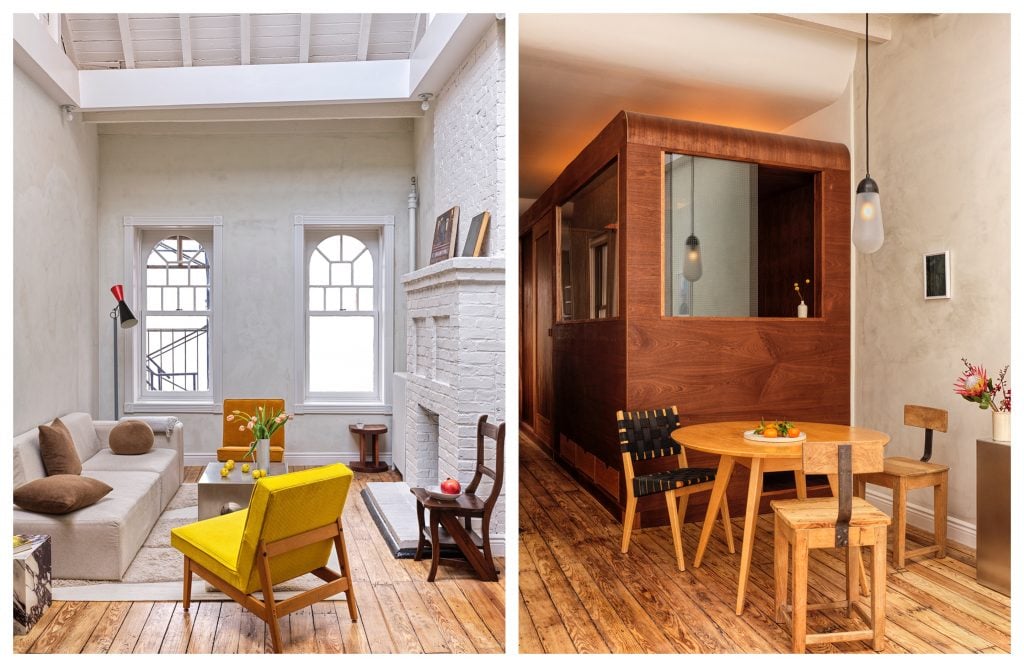
Two views of an attic apartment. Courtesy of BoND.
Rauchwerger explains their approach, “When you have to intervene with midcentury homes, many times you have to erase everything that was added that took it away from its original intention. Most of them are really this kind of boxy beach cabin. It’s really nice to distill something that you want people in the house to feel. In our house’s case, it’s like this treehouse feeling. You lay on that daybed, and you see trees in all directions.”
It’s also about asking hard hitting questions. Noam explains, “Where do people gather? Where do people gossip? Where do people party? Where do people have sex? These are the kind of questions that I think were maybe lost. That’s really the key to the Pines. It’s about one’s chosen family.”
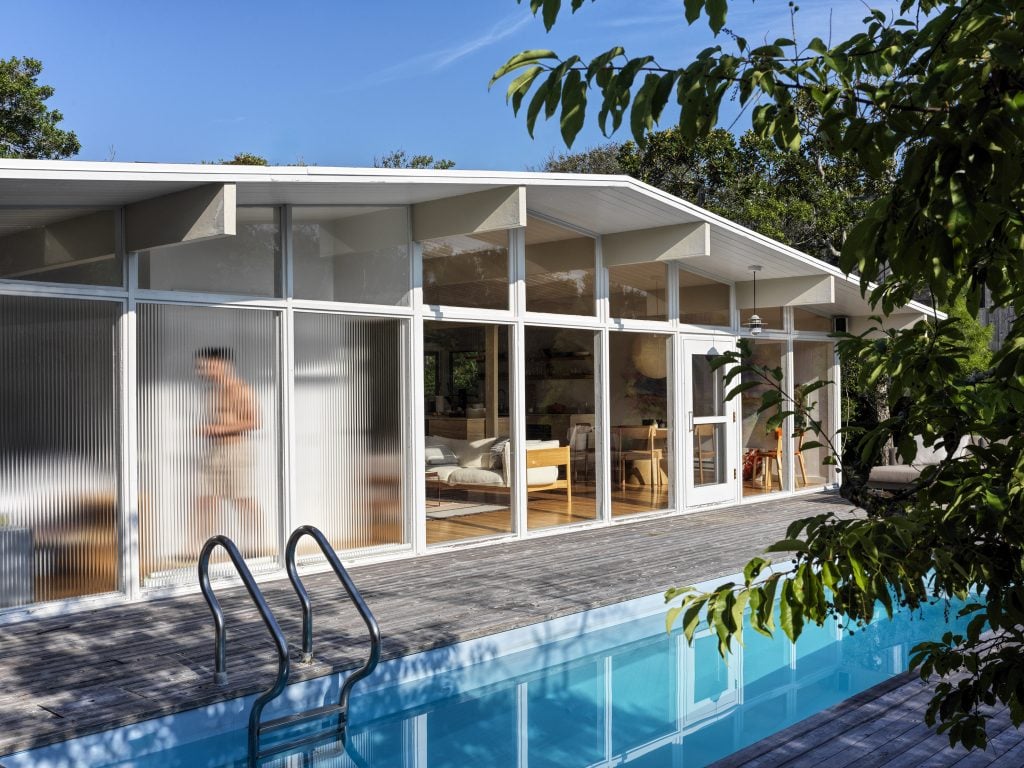
The Bass house Fire Island Pines. Photo: Chris Mottalini, courtesy of BoND.
The duo are hard at work developing furniture for a modern retailer whom they aren’t at liberty to disclose yet. “It’s like the Bauhaus tradition, so it needs to be affordable, relatively easy to mass produce, and things that people can enjoy,” Dvir says.
His partner concurs. “We really like that what we do is democratic.”
